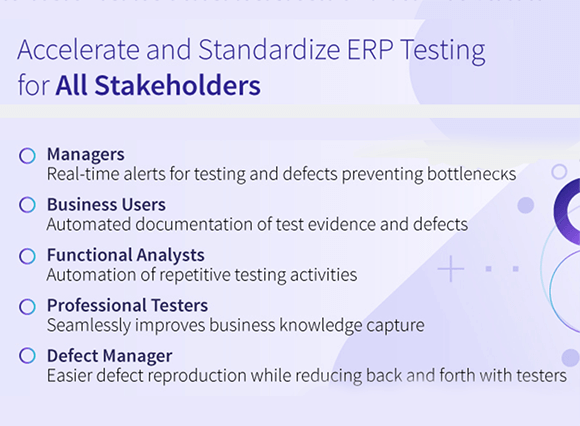Table of Content
When it comes to ERP testing, a partnership between IT and business is critical, so that Quality Assurance (QA) can extend from technical development and testing to business process testing and validation.
Onboarding and engaging all testing stakeholders are challenging. Even more so when business users across the globe need to collaborate with their peers as if they were across the hall.
Ease of use is your key to engaging business process testers. Real-time monitoring and business process-centricity are the keys to confidant test management.
But simplicity and visibility are just about the last features someone can attribute to Micro Focus Quality Center
Micro Focus Quality Center, a relic of 1990s technology, is anything but lean. QC Users often find themselves wasting time, searching for information within an outdated, cluttered user interface. Legacy test management capabilities are not scalable when agility is required.
Panaya Test Dynamix is a modernized and user-friendly test management platform designed for ERP and business process testing. While legacy testing tools focus on professional testers and generic software testing practices, Panaya Test Dynamix is leaner and addresses the needs of both business and technical users. Read on to find out how easy it is to migrate.

A Better Way
Have you ever said to yourself, ‘This can’t be right! There has to be a better way of doing this?’ If you are a test manager, chances are you’ve said it more than once. Using a test management solution like Micro Focus QC is like driving a giant SUV through a high street full of rickshaws. Sure, it’s robust, but will it be fast? Can it be used by any driver? Your testing project, like the high street, must accommodate different types of passengers: key users (pedestrians), developers (rickshaws) as well as IT testers (experienced drivers). Ignoring non-technical testers would be as conducive to your project as running all over some pedestrians would be to your SUV ride.

Where Does HPQC Fail?
Today’s test management solutions like Micro Focus QC, meant to support QA and testing, tend to deliver technically-oriented user interface and experience, consistent with the IT side of testing, rendering it useless to the Business side of testing. The result is a test management tool that fails to engage critical key users when it comes to validating your business processes. It lacks key components like collaboration, business process centricity, automatic documentation for test evidence and defects, and global project’s visibility– all conducive to delivering application changes faster.
IT is Going Agile
Practices of digital transformation are changing the way organizations manage application delivery. Change is becoming constant; it is increasingly driven by business objectives and requires IT to be more agile and deliver faster.
Connecting IT and the Business
To meet delivery with quality, IT and Business must become inherently linked from defining the change through delivery and into production. All the while, the two must work together to enable the right changes without compromising business process quality. This partnership between IT and Business is where Quality Assurance (QA) extends from technical development and testing to business testing and validation.
Now Is the Time for Lean
Going back to our street analogy, to accelerate today’s business process testing, organizations need a lean, smart, and easy-to-use vehicle, not a monster truck.
What we see with almost all Micro Focus Quality Center (QC) customers is the reluctance to change. The fear of moving away from a tool used for years often relates to sunk costs of investments that were made over the years in QC and the habits acquired over time of working with specific reports.
But what we see on the other hand is that when QC customers start using Panaya Test Dynamix they all decide to replace QC. Just a few months after their first experience with Panaya, we find they have all been ‘converted’. Why? The ease of use with Panaya is miles ahead of QC, as well as the engagement of business users. Both are ultimately conducive to your ERP quality.
Migration Is Easy!
All Panaya customers will tell you, onboarding users has never been so easy and intuitive. Consequently, once you sign up, starting your first testing project using Panaya is a matter of hours. Easily upload your existing test library into Panaya, by dragging and dropping any format test scenario: Word, Excel, or PDF into Panaya Test Box, to immediately start working in your new test environment.
Panaya Test Dynamix Saas pricing model is more flexible and straight forward than the hidden and inflated costs of Micro Focus QC (license, support, upgrades, etc.).
Panaya reduces test cycle time by 30% to 50%. Here is what a Principal Technical Program Manager at a multinational organization that replaced QC with Panaya Test Dynamix said of the change:

Want to learn more? Download our full competitive analysis report.

